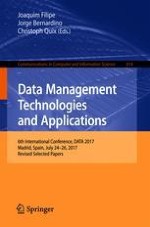2018 | Book
Data Management Technologies and Applications
6th International Conference, DATA 2017, Madrid, Spain, July 24–26, 2017, Revised Selected Papers
Editors: Joaquim Filipe, Jorge Bernardino, Christoph Quix
Publisher: Springer International Publishing
Book Series : Communications in Computer and Information Science
